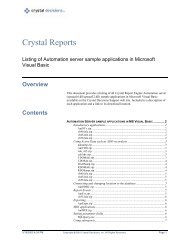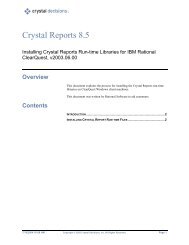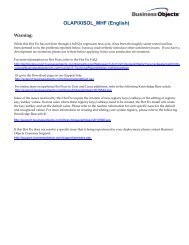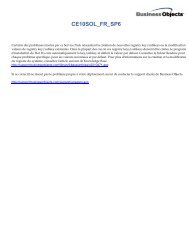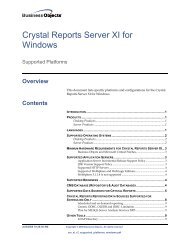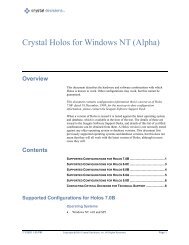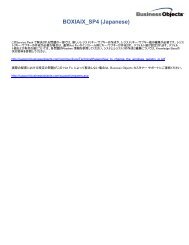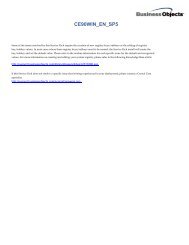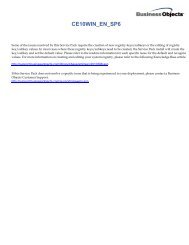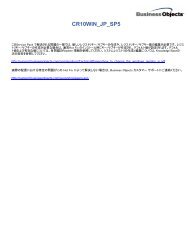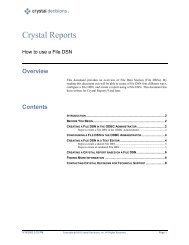Release Notes Feature Enhancements
Release Notes Feature Enhancements
Release Notes Feature Enhancements
Create successful ePaper yourself
Turn your PDF publications into a flip-book with our unique Google optimized e-Paper software.
Data Flow<br />
With a non-indexed report, Seagate Info has to look at every record in order to locate values that meet<br />
specified criteria. For instance, when a user requests a particular subset of the saved data, or when a<br />
user requests the report but only has rights to access certain records, Seagate Info filters the saved<br />
data by checking each record for the appropriate values. When you index the saved data by one or<br />
more fields, however, Seagate Info is made aware of which records contain particular values.<br />
Consequently, when a user accesses a particular subset of the saved data from the indexed field,<br />
Seagate Info can locate and format the appropriate records much more efficiently.<br />
Saved Data Indexes work entirely in the background. Users do not need to be aware of the fact that<br />
the report’s saved data is indexed. The report’s grouping, sorting, or formatting does not change when<br />
Saved Data Indexes are in use. The indexes merely allow Seagate Info to locate particular records<br />
quickly, without passing through the saved data in its entirety.<br />
Selecting Fields to Index<br />
The following guidelines serve to help users identify the situations in which it is best to index saved<br />
data and what to avoid when indexing:<br />
• Index fields that are referred to by row restriction formulas.<br />
When users access a report instance, the Info View’s row restriction formulas filter the<br />
instance’s saved data and return only those records that the user is permitted to see. If you<br />
have indexed the restricted fields, Seagate Info can locate the appropriate data quickly.<br />
• Index fields that are used in Open Info Server Plug-Ins.<br />
As with row restriction formulas, Info Server Plug-Ins filter saved data in order to display only<br />
those records that the user is permitted to see. This process is faster when you have indexed<br />
the fields that are filtered by the Plug-In.<br />
• Index fields that users frequently add to their record selection formulas.<br />
Often, many users view the same report every day and use the viewer’s Select Expert to<br />
customize record selections based on the same field. In such cases, you should index the<br />
report’s saved data by that frequently accessed field. (Ideally, the report should also be<br />
grouped on that field.)<br />
• Index fields that are referred to by the report’s record selection formula.<br />
• Do not index all of the fields in the report.<br />
Doing so can result in increased processing times. It is best to index only on the fields that meet<br />
the criteria specified above. If all of the fields meet these criteria, then users should prioritize the<br />
fields and index only some of them.<br />
• Do not index fields that contain only unique values.<br />
For instance, do not index a field such as “Last Year’s Sales,” whose values are likely to be<br />
distinct from one another. If you do so, a separate index is created for each and every value in<br />
the field.<br />
To Index Saved Data<br />
To define indexes for the saved data in a report:<br />
1. Open your report in the Info Designer.<br />
2. On the Report menu, click Saved Data Indexes.<br />
© 2000 Seagate Software<br />
4



